This, my district’s second year implementing Common Core strategies, has been the year of PROGRESSIONS. As the months flew by, the use of the word progressions increased. Being a math coach, I’ve spent time studying and discussing the progression of standards across the middle level grades with my colleagues. 
The 6th grade problem to the right kicked off a rather meaty conversation. The more we questioned, discussed, tested, reflected and questioned some more, connections between elementary and middle level division structures became apparent. This post reflects the thinking resulting from our discussion. You can see some of our notes below.
***********************************************************************
In this post:
- Fraction fact family investigation.
- Integrating elementary division structures with middle level concepts (6th grade standard of dividing fractions)
- Using visuals to model the multiplying and dividing fractions.
- Connecting fraction fact families with the initial problem 2/3 ÷ x = 8/9
***********************************************************************
Part 1: Fraction Fact Family Investigation
Elementary: Fact family triangles, number bonds & the traditional division bar are typically found in elementary math classes.
3 • 4 = 12 12 ÷ 3 = 4
4 • 3= 12 12 ÷ 4 = 3

Middle Level: What if we adapted these structures for fractions??!!!?!?
2 • 1/4 = 1/2 1/4 • 2 = 1/4
1/2 ÷ 2 = 1/4 1/2 ÷ 1/4 = 2
*********************************************************************
Let’s Investigate
Fact Family Discussion 1
1/2 ÷ 1/4 = 2
If I can write 12 ÷ 3 using a division bar, then I can do the same with 1/2 ÷ 1/4. But why use this format?
I rewrote the problem using the division bar due to the language that it’s associated with. Student’s naturally say, “How many times does 3 go into 12?” When working with fractions, we want our students to react similarly and ask, “How many 1/4ths fit into 1/2?”
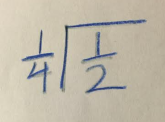


Division Bar Visual Model (Created on Desmos Activity Builder)
The Desmos created visual model is interactive. The green dot allows students to drag the divisor (1/4) and place it on top of the dividend (1/2) to determine the number of 1/4th groups that fit inside 1/2. In this case, 2 groups of 1/4 fit inside 1/2.
The visual model helps students predict or estimate the answer. One can see that the red 1/4 can easily fit inside the purple 1/2, therefore our answer must be greater than 1. When we physically move the divisor, the answer will become evident. 2 groups of 1/4 fit inside 1/2.
1/2 ÷ 1/4 = 2
*********************************************************
Fact Family Discussion 2
1/2 ÷ 2= 1/4
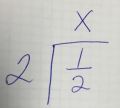


Division Bar Visual Model (Created using Desmos Activity Builder)
To reiterate:
- By rewriting the horizontally written problem using the division bar, students are more apt to ask the question, “How many 2’s go into 1/2?”. Using the division bar strengthens the conceptual understanding of dividing fractions.
- After awhile, we hope our students can also apply the, “How many”, question when the division problem is written in the horizontal form – Therefore increasing the flexibility of division structures.
- Interchanging forms brings awareness of the overarching structure of division (SMP 7).
- The purple dot allows the divisor (2) to move and cover the dividend (1/2).
- Only 1/4 of the 2 fits inside the dividend. Or Only 1/4 of the 2 covers the 1/2

1/2 ÷ 2 = 1/4
Another perspective: 1/2 divided into 2 groups means that each group will represent a size of 1/4. This strategy sets up a great segue into Fact Family Discussion 3.



**********************************************************************
Fact Family Discussion 3
2 • 1/4 = 1/2
2 groups of 1/4 equals 1/2 or 1/4 of 2 groups equals 1/2


*******************************************************************
Summarizing the Investigation


- Top row: Finding the quotient through division
- Middle row: Finding divisor through division
- Bottom row: Finding the dividend by multiplying
********************************************************************
Part 2: Connecting Fraction Fact Families
& the Inspiration Problem


As the summary acknowledges, the inspiration problem can be written with the division bar. The new arrangement offers a different perspective and possibly more clarity for the student. The division bar format highlights the missing value as the divisor, therefore to find the missing value students can divide 2/3 by 8/9.
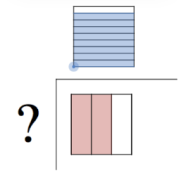
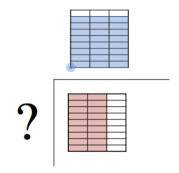
 Figure 1 Figure 2 Figure 3
Figure 1 Figure 2 Figure 3
Figure 1: How many groups of 8/9 fit inside 2/3? Since there’s more blue than red, we know that the blue (8/9) will not completely fit inside the red (2/3). It’s difficult to visually see how many 8/9 exactly fit inside 2/3 but we can estimate that the answer will be less than one.
Figure 2: A common denominator is applied. The 2 fractions are split into equal sized sections. There are 24/27 shaded blue and 18/27 shaded red. To answer the question, we need to determine how many of the 24 blue sections fit into the 18 red sections.
Figure 3: Two blue sections are moved to cover the remaining red region. Only, 18 of the 24 blue 27ths fit inside/cover the red region. 18/24 reduces to 3/4. 2/3 ÷ 8/9 = 3/4
**********************************************************************
Fact Family Algorithm

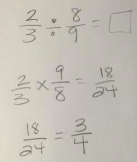
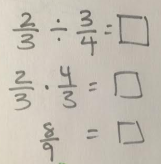

**********************************************************************
Fact Family – Visual
2/3 ÷ 3/4 = 8/9
Figure 1 Figure 2 Figure 3
Figure 1: 2/3 ÷ 3/4 = x Again we can see more blue than red, therefore the answer will be less than 1.
Figure 2: A common denominator is applied. 9/12 are shaded blue. 8/12 are shaded red. To find the answer we have to fit 9 blue sections into 8 red sections. Since it’s impossible to fit all the blue sections into the red, the answer will be less than 1.
Figure 3: Blue sections are moved to cover all the red sections showing that only 8 out of the 9 blue sections cover the red region. Therefore the answer is 8/9. 2/3 ÷ 3/4 is 8/9.
***********************************************************************
Fact Family – Visual
8/9 • 3/4 = 2/3
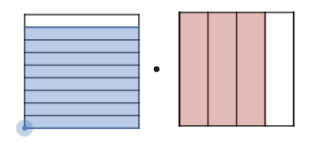
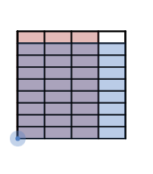 Figure 1 Figure 2
Figure 1 Figure 2
Figure 1: 8/9 • 3/4
Figure 2: 8/9 is overlaid on to 3/4. The purple section represents the answer. Out of the 36 sections, 24 are purple. The answer is 24/36 which is reduced to 2/3. 8/9 • 3/4 = 2/3
***********************************************************************
Closing Thoughts
The conversation that inspired this post was a catalyst for further exploration of fractions. Exploration that’s aiding my understanding of Common Core Progressions and proving the importance of multiple representations.
Throughout this post, I weaved in multiple representations. For the variable, I used a box, an x and sometimes I left the space blank. I wrote multiplication and division problems horizontally as well as in a fact family triangle, number bonds and with a division bar. Problems were solved using the algorithm and a visual model.
When students interpret mathematics through multiple representations, they’re displaying a deeper understanding of concepts. I believe this is an underlying theme of Common Core. Awareness of the Progressions highlights the teacher’s decision to purposely build on concepts throughout the grades by connecting previous strategies and content with current material.
For 6th graders, fractional fact families, writing a division of fraction problem with a division bar and solving them with a visual model are examples of incorporating previous strategies to understand current material.
****************************************************************
Other Posts:



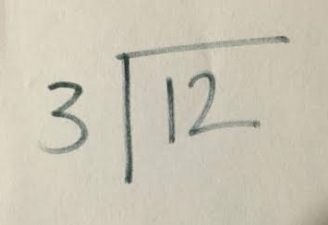

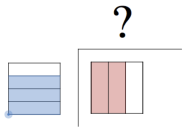
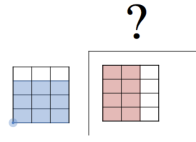

Love the 2 way thinking you have students tracking down. Can’t help but think of all the times we pigeonhole student thinking. Thanks for sharing Jenn!
LikeLike
Graham, thanks for reading and responding. I’m currently a coach who’s tinkering with fractions & multiple representations. Hoping that one of my teachers would be willing to experiment next year.
LikeLiked by 1 person
Jenn, I like how this discussion connects division of fractions to previously learned structures. I think for many students fraction division feels like some random procedure that came out of nowhere. Using the connection to fact families shows them that it is just an extension of something they already know. In the past I have written fraction division as fractions within fractions, but I like this approach much better. I hope it will help my students who have been trying to “get” fractions for the last 4 years without success. Thanks for sharing! (Also love the use of Desmos)
LikeLike
When you teach dividing fractions, please share your experience. I’d love to know how your students react to the fact family format. Thank you for reading!!
LikeLike
Pingback: Comparing Fractions w/ Desmos | Communicating Mathematically
Pingback: Why Do We Invert & Multiply? An Explanation | Communicating Mathematically
Pingback: Desmos: Ordering Fractions on a Number Line | Communicating Mathematically